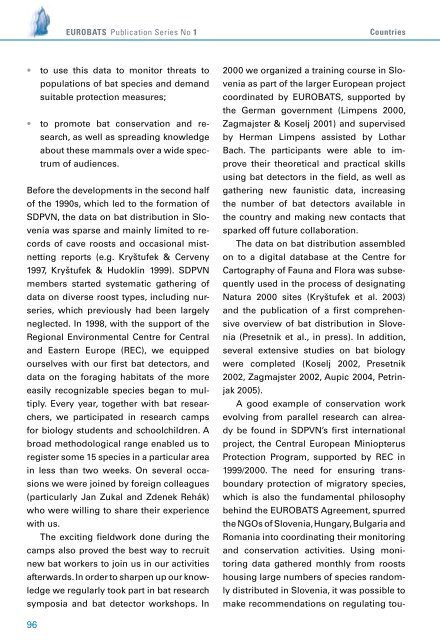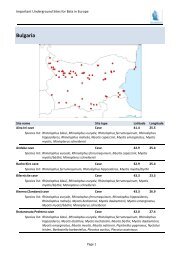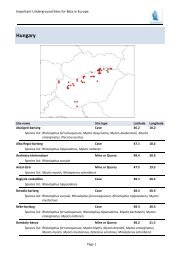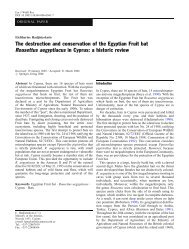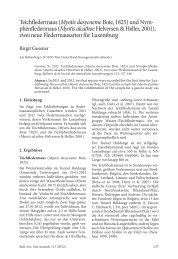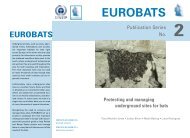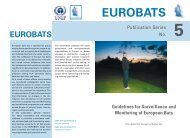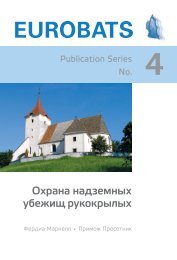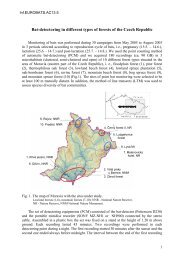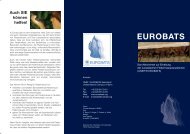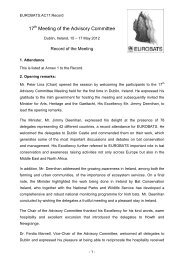1991 - 2006. EUROBATS celebrates its 15th anniversary
1991 - 2006. EUROBATS celebrates its 15th anniversary
1991 - 2006. EUROBATS celebrates its 15th anniversary
You also want an ePaper? Increase the reach of your titles
YUMPU automatically turns print PDFs into web optimized ePapers that Google loves.
96<br />
<strong>EUROBATS</strong> Publication Series No 1 Countries<br />
• to use this data to monitor threats to<br />
populations of bat species and demand<br />
suitable protection measures;<br />
• to promote bat conservation and re-<br />
search, as well as spreading knowledge<br />
about these mammals over a wide spec-<br />
trum of audiences.<br />
Before the developments in the second half<br />
of the 1990s, which led to the formation of<br />
SDPVN, the data on bat distribution in Slo-<br />
venia was sparse and mainly limited to re-<br />
cords of cave roosts and occasional mist-<br />
netting reports (e.g. Kryštufek & Cerveny<br />
1997, Kryštufek & Hudoklin 1999). SDPVN<br />
members started systematic gathering of<br />
data on diverse roost types, including nur-<br />
series, which previously had been largely<br />
neglected. In 1998, with the support of the<br />
Regional Environmental Centre for Central<br />
and Eastern Europe (REC), we equipped<br />
ourselves with our first bat detectors, and<br />
data on the foraging habitats of the more<br />
easily recognizable species began to mul-<br />
tiply. Every year, together with bat resear-<br />
chers, we participated in research camps<br />
for biology students and schoolchildren. A<br />
broad methodological range enabled us to<br />
register some 1 species in a particular area<br />
in less than two weeks. On several occasions<br />
we were joined by foreign colleagues<br />
(particularly Jan Zukal and Zdenek Rehák)<br />
who were willing to share their experience<br />
with us.<br />
The exciting fieldwork done during the<br />
camps also proved the best way to recruit<br />
new bat workers to join us in our activities<br />
afterwards. In order to sharpen up our knowledge<br />
we regularly took part in bat research<br />
symposia and bat detector workshops. In<br />
2000 we organized a training course in Slovenia<br />
as part of the larger European project<br />
coordinated by <strong>EUROBATS</strong>, supported by<br />
the German government (Limpens 2000,<br />
Zagmajster & Koselj 2001) and supervised<br />
by Herman Limpens assisted by Lothar<br />
Bach. The participants were able to improve<br />
their theoretical and practical skills<br />
using bat detectors in the field, as well as<br />
gathering new faunistic data, increasing<br />
the number of bat detectors available in<br />
the country and making new contacts that<br />
sparked off future collaboration.<br />
The data on bat distribution assembled<br />
on to a digital database at the Centre for<br />
Cartography of Fauna and Flora was subsequently<br />
used in the process of designating<br />
Natura 2000 sites (Kryštufek et al. 2003)<br />
and the publication of a first comprehensive<br />
overview of bat distribution in Slovenia<br />
(Presetnik et al., in press). In addition,<br />
several extensive studies on bat biology<br />
were completed (Koselj 2002, Presetnik<br />
2002, Zagmajster 2002, Aupic 2004, Petrinjak<br />
200 ).<br />
A good example of conservation work<br />
evolving from parallel research can already<br />
be found in SDPVN’s first international<br />
project, the Central European Miniopterus<br />
Protection Program, supported by REC in<br />
1999/2000. The need for ensuring transboundary<br />
protection of migratory species,<br />
which is also the fundamental philosophy<br />
behind the <strong>EUROBATS</strong> Agreement, spurred<br />
the NGOs of Slovenia, Hungary, Bulgaria and<br />
Romania into coordinating their monitoring<br />
and conservation activities. Using monitoring<br />
data gathered monthly from roosts<br />
housing large numbers of species randomly<br />
distributed in Slovenia, it was possible to<br />
make recommendations on regulating tou-


